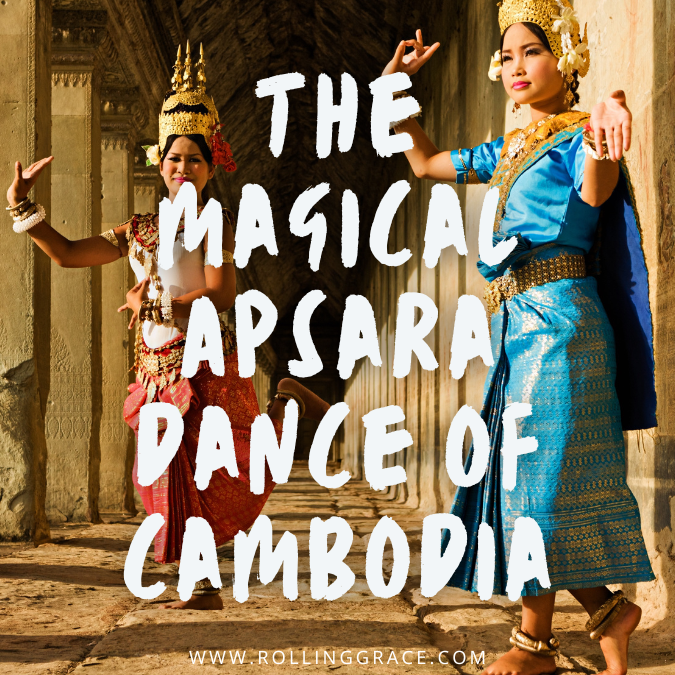Imagine an aromatic Cambodia evening unravelling before your eyes. It enfolds as the sun dips low, cascading hues of a fiery sunset across an indigo velvet sky. Amidst the chorus of cicadas, there's one spectacle that forms the heart and soul of this fascinating land, embodying quintessential Cambodia— the mesmerising display of the traditional Apsara dance!
Don't forget to share your travel & dining moments with us on Instagram by tagging @rollinggrace or #RollingGrace. Happy travelling!
Often christened as the Robam Tep Apsara, which translates to the 'Dance of the Apsara Divinities', this ethereal experience was marvellously revived by the Cambodian Royal Ballet against all odds, following its near extinction during the tempestuous times of the Khmer Rouge regime.
At Rolling Grace, we believe in diving deeper into the essence of each destination, for in these subtleties, we encounter a world teeming with culture, history and captivating tales that resonate long after the journey ends. Join us as we step into the magical realm of Apsara dances, a veritable performance poetry, that crafts an indispensable part of the Cambodian tapestry.
Read also: 10 Must-try Cambodian Dishes
Table of Content
 |
| Apsara: Traditional Cambodian Dance |
Apsara: Traditional Cambodian Dance
Khmer Apsara Dance
This traditional dance originated from the story of the union of the hermit Kampu and Apsara Mera. In Hindu and Buddhist mythology, Apsaras are supernatural
female beings of the clouds and waters. They are said to be young and beautiful,
and are adept dancers with the ability to change their shapes at will.
The Apsara
dance is performed by women gracefully dressed in close-fitting traditional
costumes known as a Sampot Sarabap, which is constructed from rich silk brocade
featuring intricate yet aesthetic details, along with a golden headdress.
 |
| An Apsara dancer dressed in a Sampot Sarabap and a golden headdress |
Origin of Apsara Dance
Apsara dance is an age-old tradition etched deep within Cambodia's vibrant cultural fabric. This ethereal dance form, as old as the temples of Angkor themselves, is said to have been birthed in the 7th century, inspired by the celestial Apsaras - divine nymphs of ancient Hindu mythology.Fabled to entertain gods with their profound beauty and elegant moves, these divine damsels were chiselled into bas-reliefs adorning the Angkorian temples, only to leap off the stone walls and come alive in the form of the enchanting Apsara dance witnessed today.
The Khmer Rouge nearly razed this spectacular tradition to the ground in the late 20th century, but the resilient Cambodians with their unwavering spirit managed to resurrect it, keeping their heritage alive and invincible.
Apsara is performed by a group of young women in a flawlessly harmonized
orientation. Every unhurried and deliberate movement is accentuated by a subtle
bend in the knees with the heels elevated and lowered to the ground with each
beat. A constant smile is attached to their faces, as they graciously flaunt
their well-mastered elegance to awestruck audiences. The
recurrent hand gestures throughout the performance give prominence to the
dance, with each motion and shift denoting different parts of the story.
 |
| Beautiful Apsara dancers performing at dinner show |
Apsara Dance Costumes
Crafted to mirror the heavenly beauty of the celestial nymphs portrayed in the ancient Hindu mythology, the Apsara ensemble is nothing short of magical. Adorned in vibrant, exquisite silk Sampots—traditional Cambodian garments—the dancers transform into divine damsels.
The intricate, golden headdresses crowned upon them, studded with forehead-spanning embellishments, imbue an air of majesty, while their hands, ornate with exotic, mystical rings, elegantly sway--an eloquence that narrates tales as old as time. Draped in a perfectly harmonised fanfare of jingling jewellery and flowing fabric, the Apsara dancers don't just don a costume; they embrace an art that speaks volumes of their rich heritage.
 |
| Apsara dancers in intricate and colourful costumes |
Best Apsara Dance in Siem Reap
Although there are occasional performances held in
temples, a more convenient option would be to attend one of the nightly performances
offered in restaurants. Pairing your dinner with this traditional dance will
surely add zest to your gastronomic experience while traveling in Siem Reap. Remember
to book ahead to secure the best seats!
Temple Balcony
Time:
19:30 (Daily)
Address:
Street 08, Krong Siem Reap
Website
| +855 12 234 565
Price:
Free
Apsara Theatre
Time: 20:30
(Daily)
Address:
Street 26, Krong Siem Reap
Website
| +855 63 963 561
Price: $25
per adult/$12.50 per child
La Noria Hotel
Time:
19.30 (Wednesday & Sunday)
Address:
River Rd, Krong Siem Reap
Price:
$6 per person
Phare Cambodian Circus
Time: 20:00 (Daily)Apsara Terrace
Time:
19:45 (Monday, Wednesday & Friday)
Address: Raffles
Grand Hotel d’Angkor, 1 Vithei Charles De Gaulle
Website
| +855 63 963 888
Price: $40
per adult/$25.50 per child
Address: Sivatha Street, Siem Reap
+855 (0) 92 630 090
Price: $12 per adult/$6 per child (free for
Kulen II Restaurant
Time: 19:30 (Daily)Address: Sivatha Street, Siem Reap
+855 (0) 92 630 090
Price: $12 per adult/$6 per child (free for
Alliance Café
Time: 20:00
(Tuesday, Thursday & Satuday)
Address: Wat Damnak,
7 Makara Street
+855 63 760 169
Price: $20
per person (including set dinner)
Don't forget to share your travel & dining moments with us on Instagram by tagging @rollinggrace or #RollingGrace. Happy travelling!
Apsara: Traditional Cambodian Dance
 Reviewed by Rolling Grace
on
January 17, 2024
Rating:
Reviewed by Rolling Grace
on
January 17, 2024
Rating:
 Reviewed by Rolling Grace
on
January 17, 2024
Rating:
Reviewed by Rolling Grace
on
January 17, 2024
Rating:












This comment has been removed by a blog administrator.
ReplyDelete